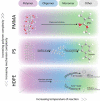Beyond Mechanical Recycling: Giving New Life to Plastic Waste
- PMID: 32160372
- PMCID: PMC7497176
- DOI: 10.1002/anie.201915651
Beyond Mechanical Recycling: Giving New Life to Plastic Waste
Abstract
Increasing the stream of recycled plastic necessitates an approach beyond the traditional recycling via melting and re-extrusion. Various chemical recycling processes have great potential to enhance recycling rates. In this Review, a summary of the various chemical recycling routes and assessment via life-cycle analysis is complemented by an extensive list of processes developed by companies active in chemical recycling. We show that each of the currently available processes is applicable for specific plastic waste streams. Thus, only a combination of different technologies can address the plastic waste problem. Research should focus on more realistic, more contaminated and mixed waste streams, while collection and sorting infrastructure will need to be improved, that is, by stricter regulation. This Review aims to inspire both science and innovation for the production of higher value and quality products from plastic recycling suitable for reuse or valorization to create the necessary economic and environmental push for a circular economy.
Keywords: catalysis; chemical recycling; circularity; plastic waste; solvolysis.
© 2020 The Authors. Published by Wiley-VCH Verlag GmbH & Co. KGaA.
Conflict of interest statement
The authors declare no conflict of interest.
Figures






References
-
- Gigault J., ter Halle A., Baudrimont M., Pascal P.-Y., Gauffre F., Phi T.-L., El Hadri H., Grassl B., Reynaud S., Environ. Pollut. 2018, 235, 1030–1034. - PubMed
-
- McKinsey, “How plastics waste could transform the chemical industry,” can be found under https://www.mckinsey.com/industries/chemicals/our-insights/how-plastics-..., 2018.
-
- The Ellen MacArthur Foundation, The New Plastics Economy: Rethinking the Future of Plastic&Catalysing Action, 2013.
-
- J. G. Olivier, J. A. H. W. Peters, Trends in Global CO2 and Total Greenhouse Gas Emissions, The Hague, 2020.
-
- European Commission, “A circular economy for plastics,” can be found under https://publications.europa.eu/en/publication-detail/-/publication/33251..., 2019.
Publication types
LinkOut - more resources
Full Text Sources
Other Literature Sources

